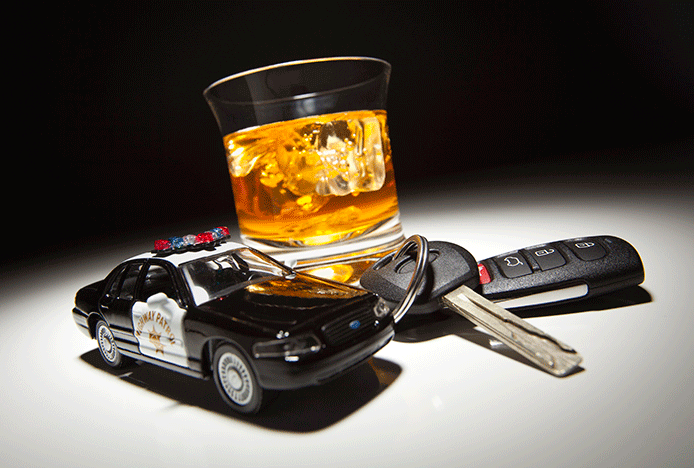Updated March 25, 2024
It is a commonly understood fact that drunk drivers are dangerous drivers. Further, we know that drunk drivers are out there. However, do you know how to spot a drunk driver in your midst and what to do once you do spot such a driver? Understanding the basics regarding identifying drunk drivers and responding accordingly can help you contribute to keeping our roadways safe.
If you or someone you care about has been injured by a drunk driver’s negligence, you shouldn’t wait to consult with an experienced Killeen personal injury attorney.
How Alcohol Affects Drivers
In Texas and most other states throughout the nation, motorists who drive with a blood alcohol concentration (BAC) of .08 or above are over the legal limit and can face drunk driving charges. However, motorists don’t have to be over the limit to experience the effects of alcohol behind the wheel, and the effects can be exceptionally dangerous.
The National Highway Traffic Safety Administration (NHTSA) reports on the effects that an increasing BAC has on drivers. Consider the following facts about BAC levels and how they affect driving ability:
At .02 BAC, there is some loss of judgment and a slight change in mood, a decline in visual functioning, and a decline in the ability to perform two tasks at once, which is required to drive safely.
At .05 BAC, there are exaggerated behaviors. Also, small-muscle control, such as focusing one’s eyes, can become an issue. Some people experience an elevated mood, increased impairment of judgment, loss of inhibitions, and lowered alertness – all of which make safe driving more difficult.
At .08 percent BAC, drivers lose muscle coordination, which can translate to problems with balance, speech, reaction times, vision, and hearing. They can have difficulty assessing danger, controlling themselves, and employing good judgment and reasoning. Memory can also be impaired.
At .1 percent BAC, motorists experience significant losses in relation to control and reaction times. At this point, speech can be slurred, coordination can be poor, and thinking can be slowed.
At .15 percent BAC, drivers have far less muscle control, and balance can be a serious issue.
When the driver who leaves you injured is charged with DWI, it can make proving negligence less challenging. However, even if he or she is not charged, there is likely to be evidence that supports impairment. Count on your trusted Killeen personal injury attorney to take the steps necessary to build your strongest claim.
Drunk Drivers
Drivers who choose to drink alcohol before getting behind the wheel endanger everyone with whom they share the road. For example, they’re more likely to head the wrong way down one-way streets or to leave their lanes and cause life-threatening head-on collisions. Alcohol plays a primary role in far too many fatal accidents, including rollovers and pileups.
Drunk drivers cause some of the deadliest accidents on our roads, but the danger doesn’t stop here. A driver who is willing to engage in this kind of risky behavior is also more likely to engage in other dangerous driving behaviors, such as interacting with a smartphone while driving.
Accidents involving drunk drivers can leave you with serious injuries and losses. If you’re struggling to overcome the effects of a recent drunk driving accident, contact a Killeen personal injury attorney.
The Hallmarks of Drunk Driving
Drivers who are under the influence of alcohol exhibit a wide range of dangerous driving practices, but there are several that you should be on the lookout for. Any of the behaviors discussed below can signal a drunk driver, and they are all exceedingly dangerous practices.
While there are some common signs that a driver may be impaired, it is important to trust your instincts. If you think a driver may present a danger, steer clear. If you spot a driver whom you think may be impaired, it is time to take action.
Inability to Stay in a Lane
We’ve all encountered motorists who seem to drift over the line only to correct themselves before drifting again. While this can be a sign of distraction, such as texting behind the wheel, it’s a behavior most closely associated with impairment.
Motorists who’ve had too much to drink experience slowed reaction time as well as a loss of control, which combine to produce a driver who just can’t seem to stay in the lane – but not for lack of trying.
Some impaired drivers go a different direction and carefully hug the centerline in an overly exaggerated effort not to stray from their lanes, which is a hallmark of drunk driving. When drivers are under the influence, it’s difficult for them to concentrate, but staying right next to the centerline can afford them a false sense of security.
Swerving in and out of Lanes
Some impaired drivers seem to forget that they share the road with others. Because their judgment and control are affected, they end up swerving in and out of traffic, which is exactly as dangerous as it sounds.
Ignoring Traffic Signs
Some drunk drivers don’t take traffic signs, lights, and signals seriously – or don’t see them at all – and as a result, they simply ignore them. Others, however, have an odd reaction to traffic signals. For example, drunk motorists may stop far short of where they should for a red light, run a red light, stop for a green light, or remain stopped when a red light turns green.
One of the most dangerous things about drunk drivers is that they are unpredictable, which makes putting as much distance between your own vehicle and theirs the best policy.
Speeding Up and Slowing Down
Impaired drivers often recognize that they’re impaired and go to considerable but misguided lengths to make up for it. This behavior can include slowing way down in an effort not to exceed the speed limit and then speeding way up when they realize they’re crawling along.
The impairment caused by alcohol makes it difficult to accurately assess one’s speed and one’s ability to navigate the road, which can get drunk drivers into trouble and makes our roads more dangerous for everyone on them.
Erratic Braking and Acceleration
Impaired drivers tend to brake excessively and take an inordinate amount of time to accelerate. This exaggerated caution is meant to make up for the fact that they’re dangerously impaired, but it only exacerbates the problem.
Unpredictable Signaling
We use turn signals to let other drivers know what we intend to do, which allows them to alter their own driving accordingly. The effective use of signals helps to keep our roads safe, but impaired drivers tend to lose track of how they’re intended to be used.
Drunk motorists might put their turn signal on long before they intend to turn or may turn it on in the middle of a sudden turn. All told, it’s difficult to say how drunk drivers will use their turn signals, but it’s safe to say that they’re unlikely to use them correctly.
Improper Headlight Usage
Drunk drivers have a hard time staying aware of their surroundings. As such, they may neglect to turn on their headlights when they are necessary due to darkness or bad weather. In addition, drunk drivers may keep their high beams on when passing other drivers, causing distraction, decreased visibility, and dangerous conditions.
Tailgating
Impaired drivers typically don’t tailgate other drivers to annoy them but instead do so in order to use them as guides. Drunk drivers aren’t able to take in all the information necessary to drive safely, and some tailgate in response to the losses they experience.
The reasoning behind this tailgating seems to be that if they just follow the driver ahead closely enough, no one will notice their impairment. However, by tailgating, drunk drivers not only highlight the fact that they’re under the influence but also make the road far more dangerous.
When motorists who are already impaired choose not to leave enough room between their own vehicles and forward traffic, they greatly increase the risk that a rear-end accident will occur. Such accidents are not only all too common but are also exceptionally dangerous.
If you’ve got someone riding the back of your vehicle even though there are plenty of empty lanes all around you, it’s a pretty good indicator that the driver is over the limit, and exiting the road may be the safest plan.
Overall Erratic Behavior
If we could focus on only one telltale sign of a drunk driver, it would be erratic driving. Drunk drivers may engage in behaviors like making illegal turns or going the wrong way down a roadway, but their impairment can also manifest itself in much more subtle ways.
As mentioned, drunk drivers are unpredictable drivers, and it’s difficult to know what they might do next. When you encounter a motorist on the road whose driving strikes you as odd – even if you can’t put your finger on exactly why – there’s a good chance that he or she is under the influence.
Drive Defensively
You learned it in Driver’s Education, and it remains true to this day – driving defensively is the safest path forward. It is your job to pay attention to the traffic all around you and to react accordingly.
If you spot a drunk, drowsy, aggressive, distracted, or otherwise dangerous driver on the road, give that driver as much space as you possibly can. If another driver’s actions catch your attention, there is probably a reason for it; heed the warning signs, and stay out of his or her way.
If you spot a driver whom you suspect of being impaired, it is important that you act quickly to help protect yourself and other motorists on the road. First and foremost, give the driver all the room that you possibly can. Drunk drivers are erratic drivers, and there is simply no way to predict what the motorist might do next.
Impaired drivers are so unpredictable and inherently dangerous that you should never attempt to pass when you identify such a driver in front of you. If the drunk driver in question is behind you, your safest option is probably exiting the roadway when it is safe to do so.
Report Impaired Drivers
After distancing yourself from a drunk driver, call 911 as soon as it is safe to do so. Relay any details you have observed that may help law enforcement identify the vehicle. For example, information related to the car’s make, model, estimated year, color, location, and behavior can all contribute to the authorities’ ability to take an exceedingly dangerous driver off the road.
Reporting drunk drivers is an important responsibility of safe drivers and may even result in saving lives.
Your Losses in an Accident Caused by a Drunk Driver
If you’re injured by an impaired driver in a car accident, seeking compensation for your related losses can go a long way toward helping you reach your most complete recovery. In addition to property damage to your vehicle and its contents, there are three primary categories of loss upon which your claim will focus.
Medical Expenses
The medical costs you face will likely begin with emergency treatment at the scene of the accident and can extend to all the following expenses:
Emergency transportation from the scene
Surgery and follow-up care
Hospitalization and attendant care
Medical treatments, tests, and procedures
Doctor care and care from specialists
Pain management
Prescription medications
Physical and occupational therapy
Rehabilitation
Home health care
Adaptive physical devices
If your injuries are very serious or lead to complications or secondary health concerns, you will likely require ongoing medical care and may have future healthcare needs that will need to be factored into your car accident claim.
Lost Income
If the car accident leaves you off the job for a considerable amount of time, the related loss in income can be significant. And if your ability to advance your career or do your job is affected, you may face financially devastating long-term losses. In addition, serious career setbacks can lead to emotional suffering that can be challenging to overcome.
Physical and Emotional Pain and Suffering
In addition to your financial losses, you should also consider the physical and emotional pain and suffering you endure. This kind of loss can be significant, but it is more difficult to calculate and adequately represent. Your seasoned Killeen personal injury attorney has the legal skill and insight to ensure that your legal damages are all well represented, including pain and suffering.
Proving the Other Driver’s Negligence
If you were injured in a car accident that was caused by someone whom you believe was under the influence of alcohol, it’s important to share your insight with the police officer at the scene. Inform the officer about any of the telltale signs of drunk driving discussed above that you witnessed.
Proving the other driver’s impairment will ultimately come down to having sufficient evidence, which can include all the following types of proof:
Your account of how the accident happened
Your account of the suspect driving practices you witnessed
Footage from dashcams and security cameras that caught any part of the accident
Photos and videos taken at the scene
Any physical evidence from the accident scene
Eyewitness accounts
The testimony of experts in relevant fields
Accident recreation models that depict how the accident played out
Personal injury claims are predicated on evidence, and your attorney is well prepared to gather all the evidence in your case in a focused effort to build your strongest claim.
If a Drunk Driver Leaves You Injured, Consult with an Experienced Central Texas Personal Injury Attorney Today
Drivers who are under the influence of alcohol or other drugs make our highways and byways that much more dangerous. Attorney Brett Pritchard at The Law Office of Brett H. Pritchard in Central Texas is committed to helping you fully recover any damages you have suffered at the hands of an inebriated driver. Mr. Pritchard has the experience, knowledge, and skill to help you. For more information, please do not hesitate to contact us online or call us at (254) 781-4222 today.







